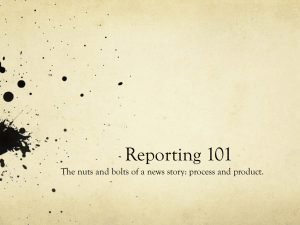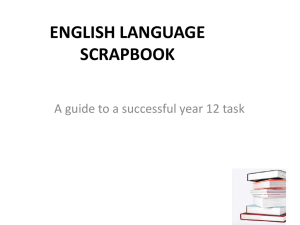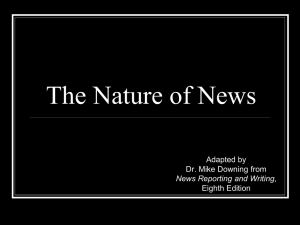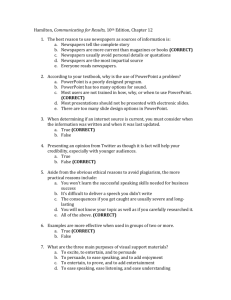Distribution + Engagement + Monetization = Journalistic Rebirth
advertisement
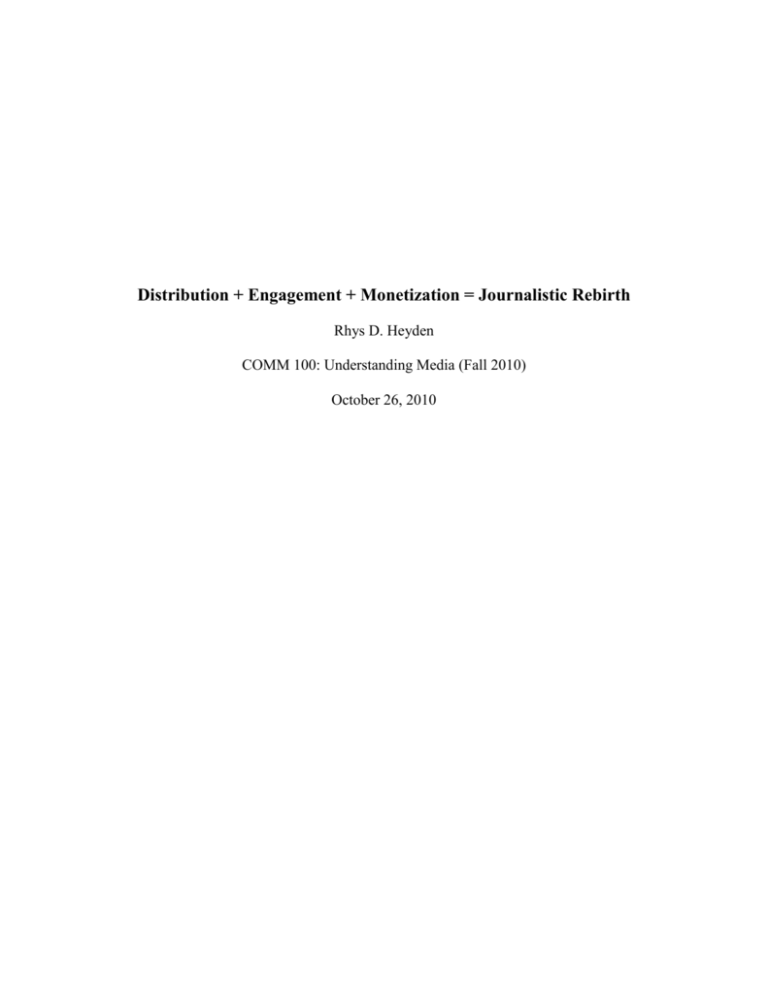
Distribution + Engagement + Monetization = Journalistic Rebirth Rhys D. Heyden COMM 100: Understanding Media (Fall 2010) October 26, 2010 I. Introduction Here is a fact that will surprise nobody: print newspapers are in deep, deep trouble. Many newspapers have been devastated by the simultaneous loss of paid subscriptions, loss of classified advertisements, and the devaluation of those ads. Most distressingly, society seems to have simply lost interest in the print form of journalism. As James Fallows points out, “In 1947, each 100 U.S. households bought an average of about 140 newspapers daily. Now they buy fewer than 50, and the number has fallen nonstop through those years” (Fallows 1). If the current model for journalism, the print newspaper, seems to be so outdated and fiscally implausible, what new model should journalism turn to? The obvious answer is the Internet, with its wealth of innovation and resources, but the path towards a completely online journalistic model is riddled with potential dangers and pitfalls. Based on the successes of three exclusively online news sources– Google News, The Daily Beast, and SB Nation – an online business model for newspapers can be organized around three principles. Namely, in order to succeed in an online media environment, newspapers should practice specialized distribution as represented by SB Nation, active engagement as represented by The Daily Beast, and innovative monetization as represented by Google News. II. Background In North America, the newspaper business was started by Benjamin Harris’ [sic] Public Occurrences, Both Forreign and Domestick in 1690. Unfortunately, the newspaper lasted for one issue before the colonial government suppressed it (Campbell 249-50). Such practices were fairly commonplace until the First Amendment to the US 1 Constitution guaranteed freedom of the press. For hundreds of years afterwards, scores of newspapers dutifully covered many of our country’s most important triumphs and disasters with widely varying levels of objectivity. Even as TV news stations started becoming popular, many Americans still turned to their daily newspapers as a reliable source of hard-to-obtain information. As Downie and Schusdon put it, “Reporting the news means telling citizens what they would not otherwise know” (Downie 10). Today, while there are still many thousands of print newspapers, Americans have turned to the Internet to obtain much of their news. Since the 1990’s, newspapers have been trying to gain a stranglehold on the online news business, with very little success. This lack of success can be attributed to many causes, but lack of creativity is certainly a major factor. As media blogger Clay Shirky explains, “The curious thing about the various plans hatched [by newspapers] in the ’90s is that they were, at base, all the same plan… the organizational form of the newspaper…was basically sound, and needed only a digital facelift” (Shirky 2). Blogs and exclusively online news sources were simply doing a better job of packaging their content. The classic model of a print newspaper seemed to be dead, and people wondered: “If the old model is broken, what will work in its place? To which the answer is: Nothing. Nothing will work. There is no general model for newspapers to replace the one the Internet just broke” (Shirky 2). Indeed, the future for old-fashioned print journalism seems to be quite bleak. Newspapers need to evolve dramatically in order to stay alive. Here are some suggestions. III. Discussion i. SB Nation and Specialized Distribution 2 SB Nation is a network of over 250 individual sports blogging websites, and was founded in 2003 by Tyler Bleszinski and Markos Moulitsas Zuniga. In April 2010, the network drew 3.6 million unique visitors to its 21 most popular sites, a remarkable feat for a company who only has 29 full-time employees (Plambeck 1). What the SB Nation network of websites offer is something that may be missing from much of mainstream media: a personal touch. Many of the sites are devoted to just one team, giving a specific group of fans a place to interact and share – a kind of virtual water cooler. In addition, bias (as a natural byproduct of fandom) is encouraged rather than shunned at SB Nation, something that separates it from traditional newspapers. As a matter of fact, sports sections have long frustrated traditional newspapers. As Joseph Plambeck explains: Sports sections historically have been loss leaders for newspapers, often with sporadic advertisements for tires, cars and niche products. Large retailers usually prefer to be in the paper’s main section and feature sections. But the coverage is a lure for readers, both in print and online. When a local team is doing well, readership often increases. (Plambeck 2) Essentially, although lucrative advertisers may often shun the sports section, local sporting news remains one of the main draws for readers. How, then, can newspapers make sports (and also news in general) a more valuable asset for advertisers? One solution is to embrace the niche market, and practice specialized distribution. SB Nation is a pioneer in the area of specialized distribution. For example, they have individual sites for fans of the Dallas Cowboys (NFL), Houston Astros (MLB), and even professional cycling. If one wants in-depth information about almost any profession sport, there is a good chance that SB Nation has a site for that. Most of their content is either generated by unpaid fans or poorly paid staff writers, also fans. While it’s quite 3 impractical for a newspaper like the San Francisco Chronicle to hire 250 writers to cover individual teams, the larger concept has validity. Modern-day news consumers want more news, and also more local news. As the Poynter Institute’s Christopher Sopher claims, “In addition to a more personal tone…readers expect personalized content. That is, content that has been selected specifically for them” (Sopher 1). When traditional newspapers try, admirably, to cover everything, they end up spreading themselves too thin. When information is available in such great breadth and depth online, this thin spread becomes even more apparent. In order to survive in an online environment, newspapers should figure out what they are especially good at covering, and target their publication towards that without shame. ii. The Daily Beast and Active Engagement The Daily Beast is an online news aggregator started by Tina Brown, former editor of Vanity Fair and The New Yorker. The site was launched on October 6, 2008, and originally featured approximately 1/3 original content, and 2/3 content gathered from various other news outlets, much like The Huffington Post. Unlike some of their competitors, Brown’s site has been able to generate more original content as time has gone by. Brown herself claims that, “The natural creativity of the staff morphed The Daily Beast very fast into what has become a newsroom. Aggregation lives on the Cheat Sheet, the video player, and in the breaking news slot in the first big box. The rest is all original, generated by Beast writers and editors” (Brown 1). The Daily Beast has also been able to draw some elite talent away from newspapers and magazines, such as The Washington Post’s Howard Kurtz and The National Review’s Christopher Buckley. 4 Although Brown herself is quite convinced of the Beast’s journalistic legitimacy, other critics are a tad more skeptical. Downie and Schudson, for example, argue that: National online news aggregators have created business models for mass audiences and advertising they hope will make them profitable. They aggregate blogs and some reporting of their own with links to and summaries of news reported by other media, along with plentiful photographs and videos. To help attract large audiences for their advertisers, they also feature entertainment gossip items and revealing photos and videos of celebrities. (Downie 59) This is a more realistic and objective description of what The Daily Beast truly is. It is hardly a paragon of journalistic excellence in the traditional sense, what with its dalliances in celebrity gossip and reliance on mostly photos and videos to tell stories. That being said, the Beast still has a valuable lesson to teach newspapers confronted with an online revolution. Simply put: in this modern era, people expect to be entertained, even by their news. The Daily Beast is entertaining. The New York Times, by and large, on the surface level, is not. It is important to not, as Neil Postman would warn, “entertain ourselves to death,” but surely mainstream newspapers can be doing more to engage their readers. As far as specifics go, the Beast is actively engaging on several different levels. The site’s design is intuitive and eye-catching. A feature called “The Cheat Sheet” wittily summarizes the top twenty news stories of the day. There are omnipresent beautiful pictures and classy, not intrusive advertisements. And, most importantly, it is completely free for the reader, encouraging rather than discouraging exploration. Although there are no concrete ways to accomplish a goal as abstract as “active engagement,” Beast style relentless experimentation can only be positive in such a volatile environment. As Clay Shirky suggests, “If the old model is broken, what will work in its place? The answer is: 5 Nothing will work, but everything might. Now is the time for experiments, lots and lots of experiments, each of which will seem minor at launch” (Shirky 5). Newspapers cannot be afraid to experiment; it is essential to their continued relevancy and survival. iii. Innovative Monetization and Google News Google News is, in terms of page views, the world’s most popular news website. Krishna Bharat of Google founded it in September 2002, and, today, it semiautomatically collects and organizes news feeds from as many as 25,000 sources in 25 different languages (Fallows 4). Although it does not produce any original content, Google News also does not heavily “excerpt” like The Huffington Post, providing only a headline and a two-line link meant to direct traffic to the content’s original creator. Newspapers have generally taken two different stances toward Google News, as Google CEO Erich Schmidt explains, “There was a set of publishers who recognized that with these tools, users were more likely to visit their Web sites…and there was another set who believed we were stealing their content” (Fallows 5). The former reaction is hardly surprising given the cultural chasm between newspaper companies and Google, which Fallows depicts as a, “wildly successful, collectively cocky, engineer-dominated, very internationally staffed West Coast tech start-up [versus] a national news establishment that is…East Coast–centric, liberal arts–heavy, dominated by organizations founded in the distant past, and at the moment strikingly downcast and even panicked” (Fallows 1). Google prides itself on constant experimentation and innovation, whereas the New York Times did not use color until 1997, The Wall Street Journal until 2002 (Newseum Visit). How, then, can a company as different from the mass media as Google offer any valuable lessons, and, more importantly, why should they? Put simply, Google 6 directs readers towards content, and, without worthwhile content to display; the service they provide is less valuable. As Fallows reports, Google executives are genuinely interested in preserving the business of good journalism, but not newspapers themselves. Google’s chief economist, Hal Varian, claims that, “Newspapers never made money on ‘news’…what paid for newspapers were the automotive sections, real-estate, home-andgarden, travel, or technology, where advertisers could target their ads” (Fallows, 3). Varian also suggests that the original business model of print newspapers is totally impractical in modern-day society: If you were starting from scratch, you could never possibly justify this business model…grow trees—then grind them up, and truck big rolls of paper down from Canada? Then run them through enormously expensive machinery, hand-deliver them overnight to thousands of doorsteps, and leave more on newsstands, where the surplus is out of date immediately and must be thrown away? Who would say that made sense? (Fallows 4) Certainly, one thing that Google knows a lot about is making money. Recently, they have collaborated with media companies on “beta projects” designed to make online journalism more innovatively monetized. “Living Stories” was collaboration with the New York Times and the Washington Post this past winter, and it essentially rigged Google searches to favor more serious and detailed reporting. Instead of being linked to a single story or (even worse) a summary, readers who searched a big topic were linked to all aspects of the paper’s coverage (history, comments, videos, similar articles). These pages featured innovative ads designed by Google’s Neal Mohan; ads that Mohan (and Fallows) believe can make online newspapers a whole lot of money. As Mohan explained, his “dynamic allocation” system, “…has generated a lift for publishers of 130 percent, versus what they did when dividing the space themselves… This [online-display] 7 market has the opportunity to be much larger… The online ad world will be a lot more attuned to who you are and what you care about, and it will be interactive in a way it never has been before” (Fallows 10). Although there certainly seems to be potential, online advertisements have not been particularly valuable for newspapers thus far, causing some to set up controversial “pay walls.” Ultimately, there is no established way to manage online journalistic monetization, but Google is confident that the right answer is out there. As Fallows suggests, Google’s optimism alone is encouraging for the media: The solution is simply the idea that there can be a solution. The organization that dominates the online-advertising world says that much more online-ad money can be flowing to news organizations. The company whose standard price to consumers is zero says that subscribers can and will pay for news. The name that has symbolized disruption of established media says it sees direct self-interest in helping the struggling journalism business. (Fallows 11) As journalism continues to expand online, it should seek out innovative ways to monetize, but not compromise its integrity. IV. Conclusion Realistically, most forms of print journalism are probably destined for extinction. If they are to survive, then they must do so online, and they must do so on a deeper level. Mere copying of the traditional newspaper form online will not be sufficient to draw a modern audience attuned to different online sensibilities. Active engagement, innovative monetization, and specialized distribution are three important principles for newspapers transitioning online. With any luck, newspapers can adapt successfully and survive. 8 Works Cited Brown, Tina. "Tina Brown Interview: The Daily Beast Turns 2." The Daily Beast. The Daily Beast, 5 Oct. 2010. Web. 23 Oct. 2010. Campbell, Richard, Christopher Martin, and Bettina Fabos. "Newspapers." Media and Culture: An Introduction To Mass Communication. Boston: Bedford/St. Martin's, 2010. 246-280. Print. Downie, Leonard, and Michael Schudson. "The Reconstruction of American Journalism: CJR." Columbia Journalism Review. Columbia Journalism Review, 20 Oct. 2009. Web. 23 Oct. 2010. Exhibition on News History, Newseum, Washington, D.C. Personal visit. Sept. 17 2010. Fallows, James. "How To Save The News." The Atlantic June 2010: 54-65. Print. Plambeck, Joseph. "Sports-Centric Web Sites Expand, and Bias Is Welcome." The New York Times 6 June 2010: NYTimes.com. Web. 8 Oct. 2010. Shirky, Clay. "Newspapers and Thinking the Unthinkable.” Clay Shirky's Internet Writings. Clay Shirky’s Internet Writings, 13 Mar. 2009. Web. 23 Oct. 2010. Sopher, Christopher. "Poynter Online – 10 Ways To Attract Younger News Consumers." Poynter Online. The Poynter Institute, 23 Sept. 2010. Web. 15 Oct. 2010. 9

